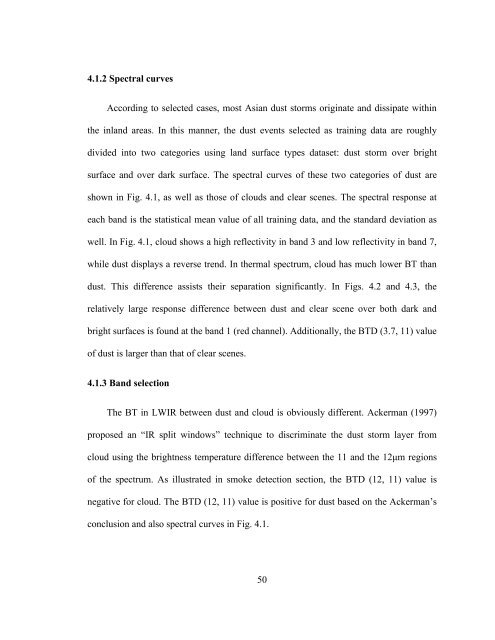i Detection of Smoke and Dust Aerosols Using Multi-sensor Satellite ...
i Detection of Smoke and Dust Aerosols Using Multi-sensor Satellite ...
i Detection of Smoke and Dust Aerosols Using Multi-sensor Satellite ...
Create successful ePaper yourself
Turn your PDF publications into a flip-book with our unique Google optimized e-Paper software.
4.1.2 Spectral curves<br />
According to selected cases, most Asian dust storms originate <strong>and</strong> dissipate within<br />
the inl<strong>and</strong> areas. In this manner, the dust events selected as training data are roughly<br />
divided into two categories using l<strong>and</strong> surface types dataset: dust storm over bright<br />
surface <strong>and</strong> over dark surface. The spectral curves <strong>of</strong> these two categories <strong>of</strong> dust are<br />
shown in Fig. 4.1, as well as those <strong>of</strong> clouds <strong>and</strong> clear scenes. The spectral response at<br />
each b<strong>and</strong> is the statistical mean value <strong>of</strong> all training data, <strong>and</strong> the st<strong>and</strong>ard deviation as<br />
well. In Fig. 4.1, cloud shows a high reflectivity in b<strong>and</strong> 3 <strong>and</strong> low reflectivity in b<strong>and</strong> 7,<br />
while dust displays a reverse trend. In thermal spectrum, cloud has much lower BT than<br />
dust. This difference assists their separation significantly. In Figs. 4.2 <strong>and</strong> 4.3, the<br />
relatively large response difference between dust <strong>and</strong> clear scene over both dark <strong>and</strong><br />
bright surfaces is found at the b<strong>and</strong> 1 (red channel). Additionally, the BTD (3.7, 11) value<br />
<strong>of</strong> dust is larger than that <strong>of</strong> clear scenes.<br />
4.1.3 B<strong>and</strong> selection<br />
The BT in LWIR between dust <strong>and</strong> cloud is obviously different. Ackerman (1997)<br />
proposed an “IR split windows” technique to discriminate the dust storm layer from<br />
cloud using the brightness temperature difference between the 11 <strong>and</strong> the 12μm regions<br />
<strong>of</strong> the spectrum. As illustrated in smoke detection section, the BTD (12, 11) value is<br />
negative for cloud. The BTD (12, 11) value is positive for dust based on the Ackerman’s<br />
conclusion <strong>and</strong> also spectral curves in Fig. 4.1.<br />
50




![[Sample B: Approval/Signature Sheet] - George Mason University](https://img.yumpu.com/21978828/1/190x245/sample-b-approval-signature-sheet-george-mason-university.jpg?quality=85)


![[Sample B: Approval/Signature Sheet] - George Mason University](https://img.yumpu.com/18694905/1/190x245/sample-b-approval-signature-sheet-george-mason-university.jpg?quality=85)






![[Sample B: Approval/Signature Sheet] - George Mason University](https://img.yumpu.com/18694552/1/189x260/sample-b-approval-signature-sheet-george-mason-university.jpg?quality=85)

![[Sample B: Approval/Signature Sheet] - George Mason University](https://img.yumpu.com/18694474/1/190x245/sample-b-approval-signature-sheet-george-mason-university.jpg?quality=85)